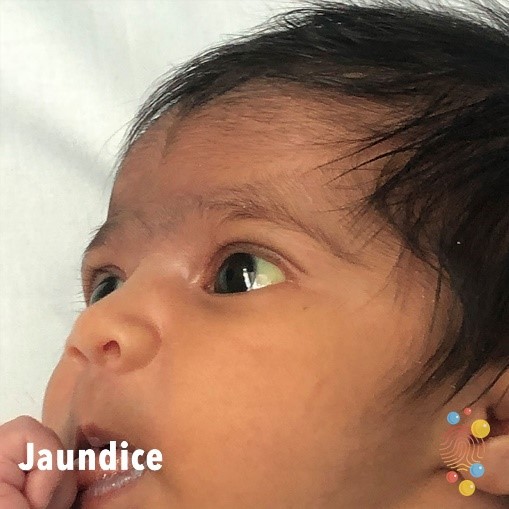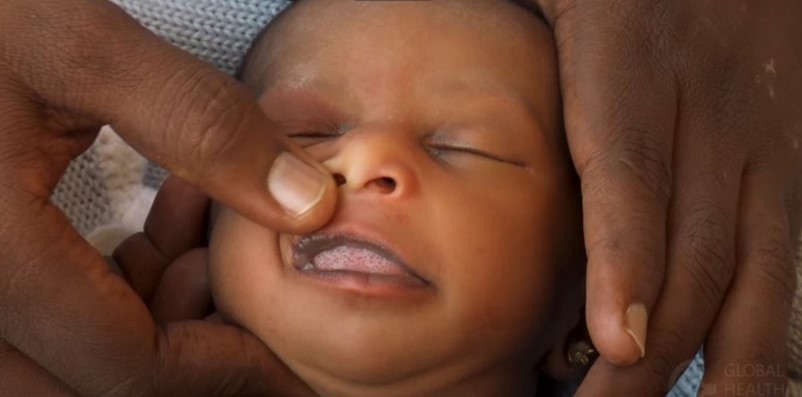Jaundice
Quick Find
Jaundice in newborn babies is common and usually harmless. It causes yellowing of the skin and the whites of the eyes. Jaundice usually develops about two days after the birth and tends to go away by the time the baby is about two weeks old.
If you notice jaundice in the first 24 hours of your baby’s life you must contact your midwife or maternity unit for advice.
Sometimes jaundice can be serious and may be caused by an underlying health condition, especially if it appears in the first 24 hours after the birth. It’s important your midwife or baby’s doctor know about it so your baby can get any treatment they need quickly. Serious cases of newborn jaundice are more common in babies born prematurely.
Jaundice in newborn babies
What causes jaundice?
The yellow colour is caused by a build-up of a substance called bilirubin. It is normal to have bilirubin, which is produced when red blood cells are broken down. Newborn babies have a high number of red blood cells, which are broken down and replaced frequently.
The bilirubin is then processed by the liver.
However, a newborn baby’s liver is not fully developed so it is less effective at removing the bilirubin from the blood.
By the time a baby is about two weeks old their liver is more effective at processing bilirubin so jaundice often corrects itself by this age without causing any harm.
How common is jaundice?
Jaundice is one of the most common conditions that can affect newborn babies.
About six out of every 10 babies develop jaundice. Eight out of 10 babies who are born prematurely before the 37th week of pregnancy can develop jaundice. For these babies it can take 5-7 days to appear and usually lasts about three weeks.
How will I know my baby has jaundice?
After birth your baby will be checked over by a midwife or doctor. Once you are home with baby you should look out for symptoms of jaundice because it can sometimes take up to a week to appear.
When you’re at home with your baby, look out for any yellowing of their skin, particularly on the head or face or in the whites of their eyes. The yellowing may increase if you gently press your fingers on the tip of their nose or on their forehead, making it easier to see. This is more obvious in babies with white skin.
Jaundice in black and brown skinned babies
Yellowing of the skin can be more difficult to see in brown or black skin. Yellowing may be more obvious elsewhere, such as:
- in the whites of their eyes
- inside their mouth
- on the soles of their feet
- on the palms of their hands
A newborn baby with jaundice may also:
- be sleepy
- not want to feed or not feed as well as usual
- have dark yellow pee (it should be colourless)
- have pale poo (it should be yellow or orange)


Testing for jaundice
Only around 1 in 20 babies has a blood bilirubin level high enough to need treatment.
If it’s thought your baby has jaundice, the level of bilirubin in their blood will need to be tested.
This can be done using a small device called a bilirubinometer, which shines light on to your baby’s skin. In most cases, a bilirubinometer is used to check for jaundice in babies.
Blood tests are usually only necessary if your baby developed jaundice within 24 hours of birth or the reading is particularly high.
For the blood test, a sample of blood is taken by pricking your baby’s heel with a small needle (the level of bilirubin in the liquid part of the blood called the serum is then measured)
The level of bilirubin detected in your baby’s blood is used to decide whether any treatment is needed.
Treatment for jaundice
Treatment for jaundice
If a blood test shows high levels of bilirubin in your baby’s blood, they may be admitted to hospital and treated with phototherapy or sometimes a blood transfusion, also called an exchange transfusion.
Phototherapy
Phototherapy is treatment with a special type of light (not sunlight). It’s used to treat jaundice by making it easier for your baby’s liver to break down the bilirubin and remove it from your baby’s blood.
Phototherapy works best when your baby’s skin is exposed to as much light as possible. Your baby will be placed under a light either in a cot or incubator with their eyes covered.
It can be stopped at intervals to enable you to feed and change your baby and give them a cuddle. If your baby’s jaundice does not improve, intensified phototherapy may be offered.
This involves increasing the amount of light used or using another source of light, such as a light blanket, at the same time.
Treatment cannot be stopped for breaks during intensified phototherapy, so you will not be able to breastfeed or hold your baby. But you can give your baby expressed milk.
During phototherapy, your baby’s temperature will be monitored to make sure they are not getting too hot and they will be checked for signs of dehydration.
Intravenous fluids may be needed if your baby is becoming dehydrated and they are not able to drink enough.
The bilirubin levels will be tested every 4-6 hours after phototherapy has started to check if the treatment is working.
Once your baby’s bilirubin levels have stabilised or started to fall, they will be checked every 6-12 hours.
Phototherapy will be stopped when the bilirubin levels fall to a safe level, which usually takes a day or two.
Phototherapy is generally a very safe and effective treatment for newborn jaundice.
Exchange transfusion
If your baby has a very high level of bilirubin in their blood or if phototherapy has not been effective, they may need a complete blood transfusion known as an exchange transfusion.
Ways to seek help
If your baby develops any signs of jaundice after this time speak to your midwife, health visitor or a GP as soon as possible for advice.
To summarise, jaundice is harmless in most cases. It usually clears up on its own by the time a baby is two weeks old. However, while jaundice is not usually a cause for concern, it is important to tell your midwife or baby’s doctor so they can decide if your baby needs treatment.